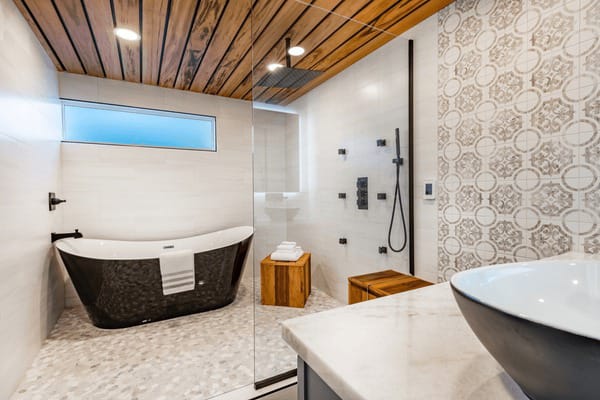HOW TO PLAN A BATHROOM REMODELING PROJECT?

Starting a remodeling project feels like solving a puzzle, struggling to find a perfect place for every item. Bathroom remodeling, especially in a bustling city like New York, gives more or less the same vibe. To reduce the complexities, we must plan our bathroom remodeling project. Moreover, a plan ensures you don’t make any mistakes, stick to the budget, and stay on track. Let’s talk about how to do bathroom remodeling in New York to help you execute an organized and stress-free bathroom makeover.
-
Define Your Goals
The first in planning a bathroom remodel is to define the scope of renovations. Are you gutting the whole bathroom, fixing some hardware, or just applying a coat of paint?
We don’t realize how many fixtures are present in a bathroom. Consider the checklist below and decide carefully what you want to add, subtract, or alter.
- Sink
- Sink faucets
- Soap holder
- Vanity
- Countertop
- Cabinets
- Open shelving
- Medicine cabinet
- Bathtub
- Bath curtains
- Shower
- Shower faucets/ valves/drain
- Shower seats
- Soap/lotion dispenser
- Lighting
- Exhaust fan
- Flooring
- Adding walls
- Wall paint/wallpaper
- Toilet
- Toilet paper stand
- Towel Stand
- Grab bars
- Mirrors
- Heating and air conditioning
This checklist lets you decide what to add, remove, or retain. The budget and timeline of the remodeling project depend upon the goals of the project and the size of your bathroom.
2. Research and Gather Ideas
The internet is full of bathroom remodeling ideas. Take your time in researching and gathering ideas that fit your style. Bathroom remodeling New York offers tons of designs to take inspiration from.
The home improvement websites are a great source of information regarding new trends. Visit the showrooms to have a real-time experience. Everything is set up so you can touch and feel to make the most of this opportunity. Spend time to select the fixture, feel its texture, envision it in your bathroom, take a picture, and create a collection of the items you like.
Similarly, do the same for all the items in the bathroom checklist, like mirrors, lighting, soap dispensers, etc. Also, visit the paint store to select the color pallet and what paint you like for your bathroom remodel.
When visiting the store, seek expert advice on what’s trending and durable. Don’t forget to ask for cheaper alternatives if you must.
3. DIY or Professionals
The next step is to decide whether you want to DIY your bathroom or hire a professional for the heavy lifting. If you have a friend or acquaintance with carpentry or renovation skills, you can ask them to chip in.
Doing it yourself indeed saves a lot of money. But might not deliver the same results. Many things require specialized knowledge and experience, like installing floors, plumbing, and wiring.
Especially if you are planning to change the layout or gut the bathroom, technical working experience is needed. Also, heavy equipment is required that homeowners usually don’t possess. So, going for a professional is advised.
Contractors provide a hefty benefit of the warranty, so you feel a sense of security that someone is there to protect the project even after the completion.
-
How to Select a Contractor?
Verify a few things before hiring any contractor
- Check their online reviews, customer feedback, and recommendations
- Visit an ongoing project to see the quality of the work
- Do not solely rely on the provided images
- Determine their tenure in the market; the old ones are more trustworthy
4. Establish Budget
At this point, you know what you want to change from defining goals. Also, by visiting stores, you have selected the likable items and taken the price quotations. In the previous step, you decided whether to hire a contractor or DIY.
Having all this information makes it easy to develop a budget. Write down the cost of materials, contractor fees, shipping costs, permit costs, and inspection fees. Furthermore, add unforeseen expenses and loss of income if it applies to your case. You will have an estimated budget.
Now, see if the budget exceeds your funds or not. If yes, look for some affordable fixtures or tiles to cut costs. Consider altering the design or asking the contractors if they have innovative ideas to reduce the cost.
5. Order Materials
Materials take weeks to deliver, especially if they are custom-made. Order them way in advance to receive them in time. Sometimes, the chosen design is short in quantity, and the store has to arrange it from another city; such entanglements take a longer lead time. It’s safe to order materials weeks before the work starts.
6. Pull Permits
Suppose your bathroom remodeling involves drastic changes like adding or removing walls. In that case, you must pull a permit before initiating the building process if the changes are minor, like lighting changes, painting, or upgrading hardware. You won’t need any permit.
Submit the plan drawing to your local jurisdiction; they will review it and grant you a permit to begin the remodel. Your contractor will help you get the needed drawings. The time taken to grant permits depends on the workload of the local jurisdiction.
7. Develop a Timeline
The time required to complete a bathroom remodeling depends upon how much work and what kind of work is needed. It can take months if the project involves heavy demolition or a complete redo. Otherwise, small changes can be made in a week or two.
Sometimes, the materials are not delivered on time, prolonging the timeline. Another factor is the issue of hidden damages in a bathroom; you have to fix them first to move on. All these factors contribute to the time needed to complete a remodeling project.
Conclusion
In a nutshell, how to plan a bathroom remodel comprises a few significant steps, as we described above. Define your goals, gather ideas, hire a contractor, establish your budget, order materials, pull permits, and develop a timeline. Once done with all these steps, it’s safe to start the project. Hopefully, your remodel will be consistent and flawless.





